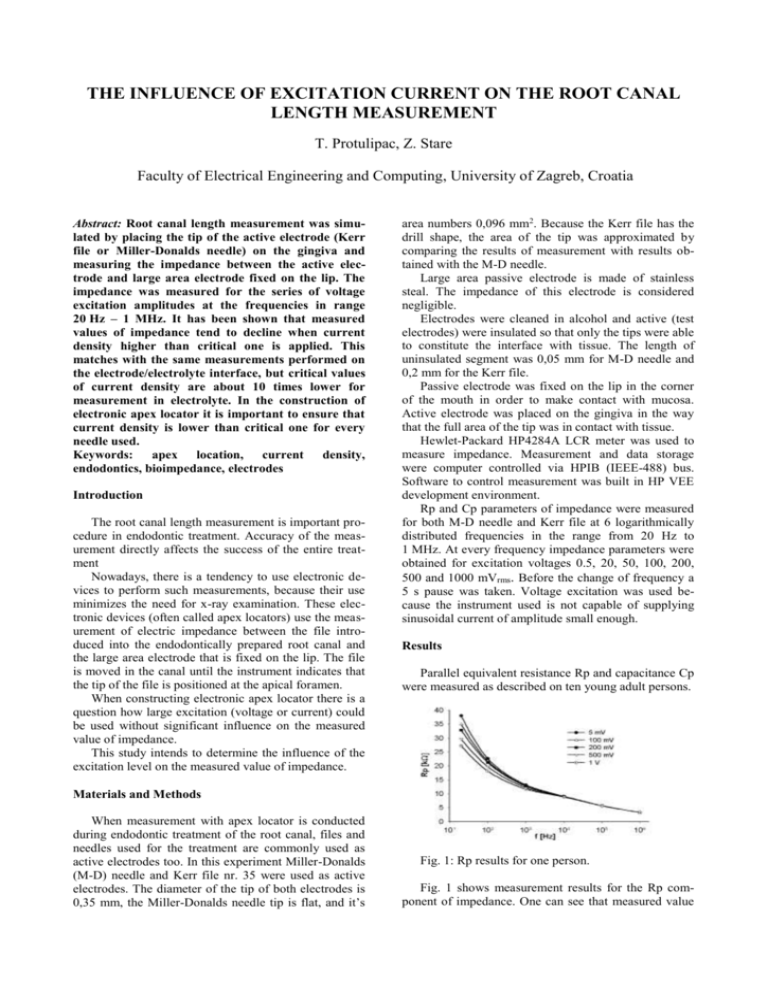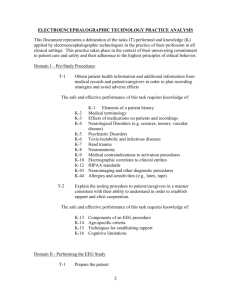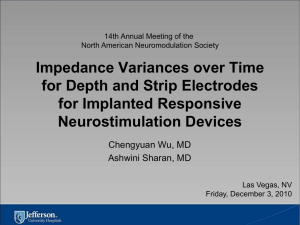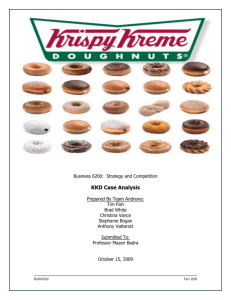Title
advertisement

THE INFLUENCE OF EXCITATION CURRENT ON THE ROOT CANAL LENGTH MEASUREMENT T. Protulipac, Z. Stare Faculty of Electrical Engineering and Computing, University of Zagreb, Croatia Abstract: Root canal length measurement was simulated by placing the tip of the active electrode (Kerr file or Miller-Donalds needle) on the gingiva and measuring the impedance between the active electrode and large area electrode fixed on the lip. The impedance was measured for the series of voltage excitation amplitudes at the frequencies in range 20 Hz – 1 MHz. It has been shown that measured values of impedance tend to decline when current density higher than critical one is applied. This matches with the same measurements performed on the electrode/electrolyte interface, but critical values of current density are about 10 times lower for measurement in electrolyte. In the construction of electronic apex locator it is important to ensure that current density is lower than critical one for every needle used. Keywords: apex location, current density, endodontics, bioimpedance, electrodes Introduction The root canal length measurement is important procedure in endodontic treatment. Accuracy of the measurement directly affects the success of the entire treatment Nowadays, there is a tendency to use electronic devices to perform such measurements, because their use minimizes the need for x-ray examination. These electronic devices (often called apex locators) use the measurement of electric impedance between the file introduced into the endodontically prepared root canal and the large area electrode that is fixed on the lip. The file is moved in the canal until the instrument indicates that the tip of the file is positioned at the apical foramen. When constructing electronic apex locator there is a question how large excitation (voltage or current) could be used without significant influence on the measured value of impedance. This study intends to determine the influence of the excitation level on the measured value of impedance. area numbers 0,096 mm2. Because the Kerr file has the drill shape, the area of the tip was approximated by comparing the results of measurement with results obtained with the M-D needle. Large area passive electrode is made of stainless steal. The impedance of this electrode is considered negligible. Electrodes were cleaned in alcohol and active (test electrodes) were insulated so that only the tips were able to constitute the interface with tissue. The length of uninsulated segment was 0,05 mm for M-D needle and 0,2 mm for the Kerr file. Passive electrode was fixed on the lip in the corner of the mouth in order to make contact with mucosa. Active electrode was placed on the gingiva in the way that the full area of the tip was in contact with tissue. Hewlet-Packard HP4284A LCR meter was used to measure impedance. Measurement and data storage were computer controlled via HPIB (IEEE-488) bus. Software to control measurement was built in HP VEE development environment. Rp and Cp parameters of impedance were measured for both M-D needle and Kerr file at 6 logarithmically distributed frequencies in the range from 20 Hz to 1 MHz. At every frequency impedance parameters were obtained for excitation voltages 0.5, 20, 50, 100, 200, 500 and 1000 mVrms. Before the change of frequency a 5 s pause was taken. Voltage excitation was used because the instrument used is not capable of supplying sinusoidal current of amplitude small enough. Results Parallel equivalent resistance Rp and capacitance Cp were measured as described on ten young adult persons. Materials and Methods When measurement with apex locator is conducted during endodontic treatment of the root canal, files and needles used for the treatment are commonly used as active electrodes too. In this experiment Miller-Donalds (M-D) needle and Kerr file nr. 35 were used as active electrodes. The diameter of the tip of both electrodes is 0,35 mm, the Miller-Donalds needle tip is flat, and it’s Fig. 1: Rp results for one person. Fig. 1 shows measurement results for the Rp component of impedance. One can see that measured value of Rp depends on the excitation frequency and amplitude. [1] Due to the usage of voltage excitation measurement results were obtained at diverse current densities. To analyse results measured on all subjects it was necessary to interpolate the Rp-J and Cp-J curves for every person. For this purpose Matlab environment and spline interpolation were used. Values of Rp and Cp were calculated for every person for the current densities in the range 0.2 200 mA/cm2. After interpolation average values and standard deviations were calculated for Rp and Cp. Fig. 2 and 3 show average values of Rp and Cp vs. current density J for M-D needle. ducted in the electrolyte [2], also the critical values of current density increase with the excitation frequency. As presented in Fig. 3 the relative change of Cp is smaller than for Rp, which means that the phase angle is changing significantly with the current density. Fig. 4 shows that measurements with the Kerr file have the same character of Rp component as measurements with M-D needle. Fig. 4: Comparison of average values of Rp for M-D needle and Kerr file. Fig. 2: Average values of Rp and 2 standard deviations ranges for 20 Hz, 100 Hz and 1 kHz. The difference between the average Rp values for the Kerr file and M-D needle is in the range of 10% of the Rp value for the M-D needle. The Differences for the Cp component are higher (40%). From the similarity of the Rp and Cp for Kerr file and M-D needle comes that the approximation of the Kerr file tip area with the area of the flat tip is acceptable. Conclusions The measurement shows that the values of Rp and Cp depend significantly on the excitation current density below 1 kHz. For the root canal length measurement it is important that for every electrode used (d= 0,1 0,85 mm typically) the current density is lower than critical one. For example, if the Kerr file nr. 10 is used at 1 kHz, then the excitation voltage must be below 100 mVrms. Fig. 3: Average values of Cp and and 2 standard deviations ranges for 20 Hz, 100 Hz and 1 kHz. Discussion From Fig. 2 and 3 one can see that for the M-D needle the value of element Rp decreases and value of Cp increases as the current density increases. Therefore, the value of impedance declines with the increase of current density. The value of impedance also declines with the increase of frequency. The relative decrease of Rp is the highest at 20 Hz, and becomes smaller as the frequency increases. At the frequency of 10 kHz it becomes negligible. If we define the critical value of current density as the one at which the value of Rp decreased and Cp increased for 10% of 20Hz value, then these values are about 10 times higher than for the measurements con- REFERENCES [1] Z. Stare, "Accuracy of electronic measurement of the root canal length", Period. Biol. 95, No. 1, pp. 149-152, Zagreb, 1993. [2] T. Ragheb and L. A. Geddes, "Electrical properties of metallic electrodes", Med. Biol. Eng. & Comput., vol. 28, pp. 182-186, 1990. [3] T. Yamamoto and Y. Yamamoto, "Non linear electrical properties of skin in the low frequency range", Med. Biol. Eng. & Comput., vol .19, pp. 302-310, 1981. [4] F. A. Duck, "Physical properties of tissue", F. A. Duck, London, 1990, pp. 167-206.







